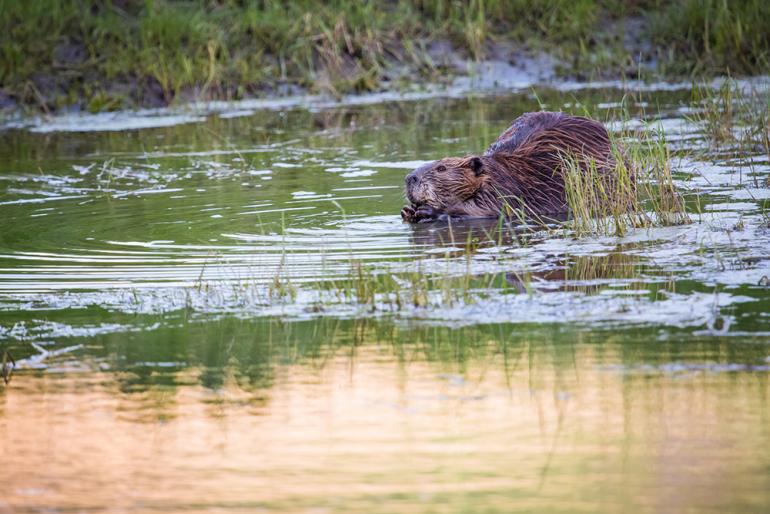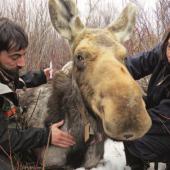Leave it to the Beavers
The wind has died and sunset is not far away now. Birds are trilling in the bushes while insects hum and buzz above the peaceful wetland. Here and there, a fish rises to snatch an unsuspecting fly for dinner. Ducks squawk sleepily from further upstream. Cody, the Black Lab who has been sitting calmly beside me on the bank of Rocky Creek, tenses suddenly. He’s on the verge of throwing himself into the water.
The cause of this canid excitement is a ripple out in the pond. A furry form approaches at a steady pace, black nose lifting and sinking, pointing the way. Bristly whiskers quiver. Small ears lie flat against blond coarse hair. With only part of its head showing, the animal navigates the waters with calm reassurance—a seasoned traveler of aquatic highways and byways. He has left his lodge to size up the impertinent intruders on his kingdom.
Cody whines, his body rigid. Head tilted in inquisitive attention, he watches the swimmer approach. Not twenty feet away, the animal stops and stares at us. We stare back, holding our breaths. SLAP!—a big flat tail lands crashing on the hitherto calm surface, sending water erupting and exploding in every direction. “Get lost!” seems to be the animal’s emphatic statement, and with that, the beaver disappears under water in one fluid motion.
While dog and human recover from this display of rodent disapproval, the beaver has retreated to the depths of the pond—his pond, one created by a dam of his own construction. Beavers build dams out of branches, logs, and mud, thus raising the water level. As a result, the beaver’s lodge is surrounded by a protective moat. High water also comes in handy for food storage in winter. Second only to humans in their ability to profoundly change the landscape, beavers create and reliably maintain wetlands, thus providing biodiversity, regulating flood waters, preventing erosion, and purifying water.
American Indians called the beaver the “sacred center” of the land because they realized how these animals create rich habitats for other animals by turning shallow valleys into wetlands. Among the beneficiaries are other mammals, fish, turtles, frogs, songbirds, and waterfowl. The tribes used beavers for food, medicine, and clothing; however, the survival of the species was never in danger. The widespread, unbridled trapping by white trappers, on the other hand, almost wiped out this beneficial creature for the sake of fashion. Ultimately, the whites’ greed and disregard for nature corrupted the Indians, and they too began to trap beavers for money and other non-essential goods. The true price the land would pay for the shortsighted exploitation of this “keystone species” would only be realized a century later.
A red-winged blackbird trills in the bushes on the island to our right while a cedar waxwing swings precariously at the end of a small twig. Rocky Creek’s raised water table has created a lush, fertile habitat teeming with life. The air is filled with the sweet melody of birdsong and the droning of insect buzz, each seemingly intent on outdoing the other. The soil is rich and fertile, providing good crops of hay in the surrounding fields and establishing new growth of cottonwood and aspen along the creek. A sense of peace and tranquility permeates this spot, the kingdom of the local beaver family.
A great disservice was done to the land and many animal species when the unregulated trapping of the 1800s and 1900s devastated beaver populations. In the absence of beavers and their wetland ecosystems, humans proceeded to build their society, draining “unproductive” wetlands. Fifty percent of wetlands were destroyed worldwide in the past century. A dangerously steep decline in biodiversity as well as flooding and eroding of stream banks has been the result. Protecting remaining wetlands is vital and supporting beavers and their habitat an important step in the right direction. But most people haven’t made the connection—to this day, we continue to destroy the busy rodents that cause “problems” on private land.
“The truth is,” says Lynn Burton, owner and guardian of this stretch of Rocky Creek property, “beavers and humans can live together in harmony once people understand that beavers are part of the ecosystem’s health plan, and that problems can indeed be resolved fairly easily.” As Cody and I scan the water, Lynn appears behind us. He scrutinizes the new growth along the creek. Since he moved to Bozeman three years ago, Lynn has spent much time to establish a constructive cooperation with the beaver population on his property—thus vastly improving the habitat along the stream. With this balanced, big-picture approach, he says, “everybody wins.”
Word has spread among the neighbors, and Lynn is busy helping landowners cope with beaver issues such as flooding and felled trees. He instructs them to wrap trees with chicken wire, and recently installed a “beaver deceiver” on Sawmill Creek preventing the industrious beaver there from blocking the culvert. Other effective devices can be installed to help solve beaver-human conflict. Lynn’s neighbors are happy to have found better solutions than killing the animals.
Movement on the opposite bank draws our attention. Cody sits up expectantly. The beaver has climbed the bank, alternately grooming his pelt with his hind claws and snacking on willow bushes. He stands upright, supported by a big flat tail. He is huge—maybe 50 pounds or so. After a casual glance in our general direction, he ignores us and tends to the more important things in life: a nice appearance, and fine dining.
As we watch Blondie grub and groom, we hope that the time has come when people rethink their relationship to nature. By working with the forces of nature and the wisdom of our fellow animals, we can all learn from each other and ensure a healthy habitat for all. Not all landowners may feel that way about these furry sawyers, however. Trappers are still regularly dispatched to kill overly eager beavers. However, the problems will not go away, because new beavers soon occupy the empty spots. It’s much better, says Lynn, to work with the existing beavers and find a way to live together. “Beavers are very smart,” he says, squinting into the sunset. “It certainly makes sense to work with them and not against them. In return, they will improve the habitat on your property, adding value to it.”
SPLASH! Another beaver tail smacks the water in the middle of the pond. But wait—this is a peculiar looking beaver. He’s jet-black and enormous, bearing a strange resemblance to a dog. Cody’s curiosity has finally won. He’s in the water paddling furiously toward the other side. The birds hold their breaths in unison and in this instant, the sun dips below the horizon. A sudden breeze rustles the willow bushes. Cody looks around. The beaver is gone.













